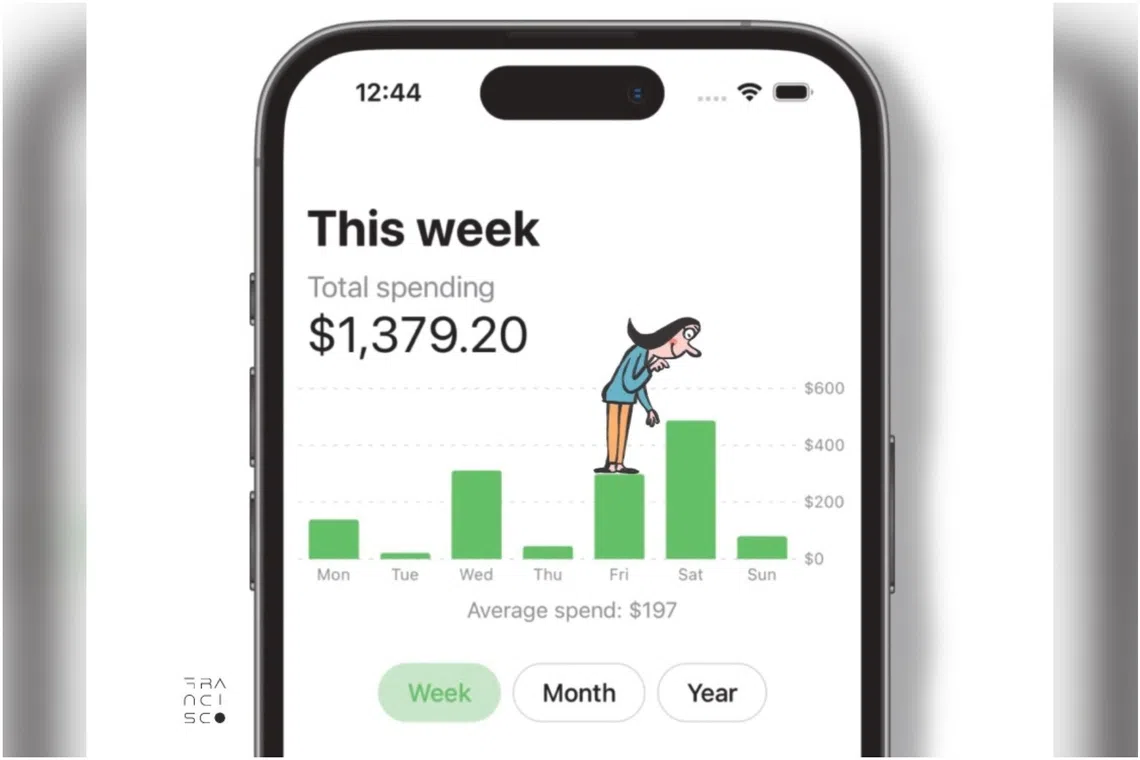Young and Savvy: I used a money insights app for 3 months – here’s what I learnt
Sign up now: Get tips on how to grow your career and money

Getting insights into my spending patterns, rather than simply tracking expenses, proved a fruitful exercise.
ST ILLUSTRATION: MANUEL FRANCISCO
Follow topic:
SINGAPORE – For years, I kept track of my expenses on a simple money app, keying in lunch costs, MRT ticket prices and price tags after shopping, checking how much I managed to save at the end of each month.
But lately, I have been experimenting with the OCBC Money Insights feature within the bank’s app, which allows me to set goals, break my expenses down by category, and set budgets for each one.
It even gave me projected savings one year from now if I kept up my spending habits.
Here’s what I learnt:
Simply eating ‘cai fan’ does not move the needle
“Cai fan” – or economy rice – is the go-to buzzword for my friends and me when we feel broke or have spent a great deal of money travelling.
“It’s okay, I can just go home and eat cai fan,” my friend says when she has spent thousands overseas.
But does simply switching to cheaper meals work in the grand scheme of finances?
Using the app to track my food expenditure over three months, I realised that no matter what I did, food expenses remained roughly the same – at best, I saved less than $100 during the months I consciously scrimped on food.
Perhaps this is due to my own dining patterns – I usually cook my lunch and dine out only once or twice a week.
I also patronise mid-priced cafes or restaurants, rather than splashing out on Michelin-starred meals.
So when I tried to cut down on food costs – say, eating at the food court instead of a cafe – it hardly made a difference.
Going without getting bubble teas did not help much either; I bought juice to “reward” myself.
Maybe eating “cai fan” would have made a difference if I was the kind of person who spends on fine dining every weekend – but no real trimming of expenses took place in my case.
A Straits Times survey of around 1,000 young people aged 18 to 30 found that nearly one-third of a young adult’s spending in Singapore is on food.
The survey carried out by market research firm Kantar also found that young people mostly spend their food money at hawker centres and food courts.
This was followed by grocery shopping, then dining at restaurants and cafes.
I have pretty much the same dining habits, and trying to trim food expenses doesn’t really impact my long-term spending.
Still, the app had some useful tips on how to trim food expenses if I really wanted to, including cooking at home, which can be more healthy too. It also recommended making a shopping list before hitting the store, rather than grabbing things off the shelf that might seem good then.
Saving too much
It seems strange to say I was saving too much. But on closer look, the app was really suggesting that I divert some of the savings to investments instead.
The app registered that some months I saved over 10 per cent of my pay, and recommended that I look into investment products.
OCBC Bank’s head of digital business in Singapore Ng Lee Peng said the recommended breakdown is to save at least 10 per cent of one’s monthly income, invest 10 per cent, and not spend more than 15 per cent on insurance.
Interestingly, it seems that young adults in Singapore do save more than 10 per cent of their income. The ST survey showed that respondents saved an average of 28 per cent of their personal income, invested 20 per cent, and designated 45 per cent for expenditure.
This is consistent with OCBC’s surveys as well, which found that those in their 20s saved 32 per cent of their personal monthly income in cash, while those in their 30s saved 30 per cent of their income.
Singaporeans in their 20s also put aside around a quarter of their income for investments, and over 20 per cent for insurance.
For some time, I told myself that putting money into high-interest savings accounts could also be a form of investment, in the sense that I got an extra $200 or so every month from the accounts.
But perhaps it is time to allocate some of that to more investments.
Setting savings goals for travel is a wake-up call
Halloween might have just passed, but nothing was scarier than trying to set up a savings goal in the app for a trip I had planned to take in 2026 and realising I actually did not have enough saved up for it.
I am one of those people who take a glance at their bank balance and decide: “All right, that’s enough; I can go on holiday!”
But while setting up a savings goal for my United Kingdom trip in March 2026, the app told me I had to put aside over $700 each month from September onwards – which was when I first started planning the trip.
While setting the savings goal would not “lock up” my money and prevent me from transferring it out digitally or withdrawing it, it was still a commitment. The money would be earmarked for my goal and could be “released” to my account balance at any time, but it still felt like I was “losing” $700 a month.
Suddenly, budgeting for the trip felt so much more real when I felt the pinch every month.
Recurring expenses add up
I thought I was doing quite well as I had stopped several streaming subscriptions earlier. Having no Disney Plus, Netflix or any other streaming apps might seem like I had streamlined everything I could.
But I realised I still had many other recurring subscriptions whose costs were adding up over time – Spotify, YouTube Premium, Photoshop, Google Drive cloud storage.
I even had subscriptions I had forgotten I had.
Ms Shirley Tan, chief marketing officer at Etiqa Insurance Singapore, said there comes a time to just “exorcise” the hidden expenses that quietly drain your wallet each month.
Conducting a personal finance audit can help uncover hidden costs such as unused subscriptions, overlapping insurance coverage or unnecessary service fees that may be haunting your budget, she said.
I realised that when I sign up for something new, I account for it once but I do not really track how it affects my budget every month.
Ultimately, I think it is not worth scrimping on things that truly bring joy – if it’s within budget. For instance, cutting the barely used subscriptions might be a more worthy endeavour than holding yourself back from that bubble tea you really want today.
And if there’s a concert that you have waited for or a long-awaited trip with friends, it is no crime to splurge and enjoy it.
While eating “cai fan” will not help you recoup the thousands spent on travel, perhaps cutting down in other ways – like subscriptions – and growing your money through investments might help to balance the books.


